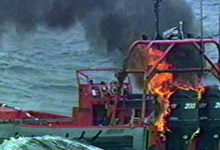The Office of Naval Research successfully disables a small target vessel using a solid-state, high-energy laser mounted onto the deck of the Navy’s self-defense test ship, former USS Paul Foster (DD 964). Credit: US Navy photograph
The maritime laser from an older photo
UPDATE – I have a summary of the navy laser weapons program from a 53 page report to Congress.
The Navy and Northrop Grumman completed at-sea testing of the Maritime Laser Demonstrator (MLD), which validated the potential to provide advanced self-defense for surface ships and personnel by keeping small boat threats at a safe distance.
“The success of this high-energy laser test is a credit to the collaboration, cooperation and teaming of naval labs at Dahlgren, China Lake, Port Hueneme and Point Mugu, Calif.,” said Chief of Naval Research Rear Adm. Nevin Carr. “ONR coordinated each of their unique capabilities into one cohesive effort.”
The latest test occurred near San Nicholas Island, off the coast of Central California in the Pacific Ocean test range. The laser was mounted onto the deck of the Navy’s self-defense test ship, former USS Paul Foster (DD 964).
Carr also recognized the Office of the Secretary of Defense’s High Energy Joint Technology Office and the Army’s Joint High Powered Solid State Laser (JHPSSL) program for their work. MLD leverages the Army’s JHPSSL effort.
“This is the first time a HEL, at these power levels, has been put on a Navy ship, powered from that ship and used to defeat a target at-range in a maritime environment,” said Peter Morrison, program officer for ONR’s MLD.
In just slightly more than two-and-a-half years, the MLD has gone from contract award to demonstrating a Navy ship defensive capability, he said.
“We are learning a ton from this program—how to integrate and work with directed energy weapons,” Morrison said. “All test results are extremely valuable regardless of the outcome.”
Additionally, the Navy accomplished several other benchmarks, including integrating MLD with a ship’s radar and navigation system and firing an electric laser weapon from a moving platform at-sea in a humid environment. Other tests of solid state lasers for the Navy have been conducted from land-based positions.
Having access to a HEL weapon will one day provide warfighter with options when encountering a small-boat threat, Morrison said.
But while April’s MLD test proves the ability to use a scalable laser to thwart small vessels at range, the technology will not replace traditional weapon systems, Carr added.
“From a science and technology point of view, the marriage of directed energy and kinetic energy weapon systems opens up a new level of deterrence into scalable options for the commander. This test provides an important data point as we move toward putting directed energy on warships. There is still much work to do to make sure it’s done safely and efficiently,” the admiral said.
If you liked this article, please give it a quick review on ycombinator or StumbleUpon. Thanks

Brian Wang is a Futurist Thought Leader and a popular Science blogger with 1 million readers per month. His blog Nextbigfuture.com is ranked #1 Science News Blog. It covers many disruptive technology and trends including Space, Robotics, Artificial Intelligence, Medicine, Anti-aging Biotechnology, and Nanotechnology.
Known for identifying cutting edge technologies, he is currently a Co-Founder of a startup and fundraiser for high potential early-stage companies. He is the Head of Research for Allocations for deep technology investments and an Angel Investor at Space Angels.
A frequent speaker at corporations, he has been a TEDx speaker, a Singularity University speaker and guest at numerous interviews for radio and podcasts. He is open to public speaking and advising engagements.




